Submitted:
20 March 2024
Posted:
22 March 2024
You are already at the latest version
Abstract
Keywords:
1. Introduction
2. Materials and Methods
2.1. Study Area
2.2. Grazing Management, Pasture Measurements and Sampling
2.3. Cone Index Measurements
2.4. Observation of Sheep's Grazing Behavior and Spots Preferences
2.4.1. Animal Observations
2.5. Meteorological Conditions
2.6. Statistical Analysis of Data
2.6.1. Pasture Height and Quality
2.6.2. Cone Index
2.6.3. Animal’s Location Preferences
3. Results
3.1. Grazing Days, Stocking Rate and Pasture Height
3.2. Characterization of the Nutritional Value
3.3. Preferred Grazing Locations versus Average Height of Pasture
3.4. Relationship between Preferred Grazing Locations and Floristic Composition
3.5. Soil Compaction Measured by Cone Index
4. Discussion
4.1. Relationship among Climatic Variables and, Height and Pasture Quality
4.2. Relationship between Preferred Grazing Locations, Type of Grazing, Stocking Rate, Floristic Composition, and Pasture Height, during the Observation Period
5. Conclusions
Author Contributions
Funding
Institutional Review Board Statement
Informed Consent Statement
Data Availability Statement
Acknowledgments
Conflicts of Interest
Appendix A
| Botanical Specie | spot 8 | spot 9 | spot 18 | spot 19 | spot 30 | spot 31 | spot 32 | spot 45 | spot 47 |
|---|---|---|---|---|---|---|---|---|---|
| Chamaemelum mixtum | 0 | 0 | 1 | 0 | 0 | 0 | 0 | 0 | 0 |
| Erodium cicutarium subsp. bipinnatum | 0 | 1 | 1 | 1 | 1 | 0 | 1 | 0 | 1 |
| Calendula arvensis | 0 | 1 | 0 | 0 | 0 | 0 | 0 | 0 | 0 |
| Chamaemelum fuscatum | 1 | 0 | 0 | 0 | 0 | 0 | 0 | 0 | 0 |
| Diplotaxis catholica | 1 | 1 | 1 | 0 | 1 | 0 | 1 | 0 | 1 |
| Echium plantagineum | 1 | 0 | 1 | 1 | 1 | 0 | 1 | 1 | 1 |
| Geranium molle | 0 | 1 | 0 | 0 | 0 | 0 | 0 | 0 | 0 |
| Hypochaeris glabra | 0 | 1 | 0 | 0 | 0 | 0 | 0 | 0 | 0 |
| Iris xiphium | 0 | 1 | 0 | 0 | 0 | 0 | 0 | 0 | 0 |
| Leontodon taraxacoides | 0 | 0 | 1 | 0 | 0 | 0 | 0 | 1 | 1 |
| Ornithopus compressus | 1 | 0 | 0 | 0 | 0 | 1 | 0 | 1 | 0 |
| Plantago lanceolata | 0 | 0 | 0 | 1 | 0 | 0 | 0 | 0 | 0 |
| Plantago sp | 0 | 1 | 0 | 0 | 0 | 0 | 0 | 0 | 0 |
| Ranunculus ollissiponensissubsp. ollissiponensis | 0 | 0 | 0 | 0 | 0 | 0 | 0 | 1 | 0 |
| Senecio jacobaea | 0 | 0 | 0 | 0 | 1 | 0 | 0 | 0 | 0 |
| Senecio vulgaris | 1 | 1 | 1 | 1 | 1 | 0 | 1 | 0 | 0 |
| Spergula arvensis | 1 | 0 | 0 | 0 | 0 | 0 | 0 | 0 | 0 |
| Stachys arvensis | 0 | 0 | 0 | 0 | 1 | 0 | 1 | 0 | 0 |
| Stellaria media | 0 | 0 | 0 | 1 | 0 | 0 | 0 | 0 | 0 |
| Urtica urens | 0 | 0 | 0 | 1 | 0 | 0 | 0 | 0 | 0 |
| Genus Trifolium | 1 | 0 | 0 | 0 | 0 | 1 | 0 | 0 | 0 |
| Several grass species | 1 | 0 | 0 | 1 | 1 | 0 | 1 | 1 | 1 |
| Botanical Specie | spot 3 | spot 4 | spot 5 | spot 8 | spot 10 | spot 11 | spot 12 | spot 17 | spot 20 | spot 30 | spot 31 | spot 41 | spot 47 |
|---|---|---|---|---|---|---|---|---|---|---|---|---|---|
| Agrostis castellanaBoiss. & Reut. | 0 | 0 | 0 | 0 | 0 | 0 | 0 | 0 | 0 | 0 | 0 | 0 | 1 |
| Agrostis pourretiiWilld. | 0 | 1 | 0 | 0 | 0 | 0 | 1 | 0 | 0 | 0 | 0 | 0 | 0 |
| Anagallis arvensisL. | 0 | 0 | 1 | 0 | 0 | 0 | 0 | 0 | 0 | 0 | 1 | 0 | 0 |
| Anthriscus caucalisM.Bieb. | 0 | 0 | 1 | 0 | 0 | 0 | 0 | 0 | 0 | 0 | 0 | 0 | 0 |
| Arum italicumsubsp. italicum | 0 | 0 | 1 | 0 | 0 | 0 | 0 | 0 | 0 | 0 | 0 | 0 | 0 |
| Avena barbatasubsp. lusitanica (Tab.Morais) Romero Zarco | 0 | 0 | 0 | 0 | 0 | 1 | 0 | 0 | 0 | 0 | 0 | 0 | 0 |
| Bromus hordeaceus L. | 0 | 0 | 0 | 1 | 1 | 1 | 0 | 0 | 0 | 1 | 1 | 1 | 1 |
| Bromus sterilis L. | 1 | 0 | 1 | 0 | 1 | 0 | 0 | 0 | 0 | 0 | 0 | 0 | 0 |
| Callitriche stagnalis | 0 | 0 | 0 | 0 | 0 | 0 | 1 | 1 | 0 | 0 | 0 | 0 | 0 |
| Carduus tenuiflorusCurtis | 1 | 0 | 1 | 0 | 0 | 0 | 0 | 0 | 1 | 0 | 0 | 0 | 0 |
| Cerastium glomeratumThuill. | 1 | 0 | 1 | 0 | 0 | 0 | 0 | 1 | 0 | 1 | 1 | 0 | 0 |
| Chamaemelum fuscatum(Brot.) Vasc. | 0 | 1 | 0 | 0 | 0 | 0 | 1 | 1 | 0 | 0 | 0 | 0 | 0 |
| Chamaemelum mixtum | 0 | 1 | 0 | 1 | 1 | 1 | 0 | 1 | 1 | 1 | 1 | 1 | 1 |
| Crepis capillaris(L.) Wallr. | 0 | 0 | 0 | 1 | 1 | 0 | 0 | 0 | 0 | 0 | 1 | 0 | 0 |
| Crepis vesicariasubsp. taraxacifolia (Thuill.) Thell. | 1 | 1 | 0 | 0 | 1 | 1 | 0 | 0 | 0 | 0 | 1 | 0 | 0 |
| Cynodon dactylon(L.) Pers. | 0 | 0 | 0 | 0 | 0 | 0 | 1 | 1 | 0 | 1 | 0 | 0 | 0 |
| Diplotaxis catholica(L.) DC. | 1 | 1 | 0 | 1 | 0 | 1 | 0 | 0 | 1 | 0 | 1 | 1 | 1 |
| Echium plantagineumL. | 0 | 1 | 0 | 1 | 0 | 1 | 0 | 1 | 1 | 1 | 1 | 1 | 0 |
| Erodium cicutariumsubsp. bipinnatum (Cav.) Tourlet | 0 | 0 | 1 | 0 | 0 | 0 | 0 | 0 | 1 | 0 | 0 | 0 | 1 |
| Geranium molleL. | 1 | 0 | 1 | 0 | 1 | 1 | 1 | 0 | 0 | 1 | 0 | 0 | 0 |
| Geranium purpureumVill. | 0 | 0 | 0 | 0 | 0 | 0 | 0 | 0 | 0 | 1 | 0 | 0 | 0 |
| Hedypnois cretica(L.) Dum.-Courset | 1 | 0 | 0 | 0 | 1 | 1 | 0 | 0 | 1 | 0 | 0 | 0 | 0 |
| Hordeum murinumsubsp. leporinum (Link) Arcang. | 1 | 0 | 1 | 1 | 0 | 1 | 0 | 0 | 0 | 0 | 0 | 1 | 1 |
| Hypochaeris glabraL. | 0 | 0 | 0 | 0 | 1 | 0 | 0 | 0 | 1 | 0 | 0 | 0 | 0 |
| Hypochaeris radicataL. | 0 | 0 | 0 | 0 | 1 | 0 | 0 | 1 | 0 | 1 | 1 | 0 | 0 |
| Juncus bufoniusL. | 0 | 0 | 0 | 0 | 0 | 0 | 1 | 1 | 0 | 1 | 1 | 0 | 0 |
| Lathyrus angulatusL. | 0 | 0 | 0 | 0 | 0 | 0 | 0 | 0 | 0 | 1 | 1 | 0 | 0 |
| Leontodon taraxacoides(Vill.) Mérat | 0 | 0 | 0 | 0 | 1 | 1 | 0 | 1 | 0 | 1 | 1 | 0 | 0 |
| Lythrum borysthenicum(Schrank) Litv. | 0 | 1 | 0 | 0 | 0 | 0 | 1 | 1 | 0 | 0 | 0 | 0 | 0 |
| Medicago polymorphaL. | 1 | 0 | 1 | 0 | 0 | 1 | 0 | 0 | 0 | 0 | 0 | 0 | 0 |
| Mentha pulegiumL. | 0 | 1 | 0 | 0 | 0 | 0 | 0 | 0 | 0 | 0 | 0 | 0 | 0 |
| Ornithopus compressusL. | 0 | 0 | 0 | 0 | 1 | 0 | 0 | 0 | 0 | 1 | 0 | 0 | 0 |
| Plantago coronopusL. | 0 | 1 | 0 | 0 | 0 | 1 | 1 | 1 | 0 | 0 | 1 | 0 | 0 |
| Plantago lagopusL. | 0 | 0 | 0 | 1 | 1 | 1 | 0 | 0 | 1 | 1 | 1 | 0 | 0 |
| Plantago lanceolataL. | 0 | 0 | 0 | 0 | 0 | 0 | 0 | 0 | 0 | 0 | 1 | 0 | 0 |
| Poa annuaL. | 0 | 1 | 0 | 0 | 0 | 0 | 1 | 1 | 0 | 0 | 0 | 0 | 0 |
| Polygonum aviculareL. | 0 | 0 | 0 | 0 | 0 | 0 | 1 | 0 | 0 | 0 | 0 | 0 | 0 |
| Polypogon maritimusWilld. | 0 | 0 | 0 | 0 | 0 | 0 | 0 | 1 | 0 | 0 | 0 | 0 | 0 |
| Ranunculus parviflorusL. | 1 | 0 | 1 | 0 | 0 | 0 | 0 | 0 | 0 | 0 | 1 | 0 | 1 |
| Rumex bucephalophorusL. | 0 | 0 | 0 | 1 | 1 | 1 | 1 | 0 | 0 | 0 | 1 | 0 | 0 |
| Rumex pulchersubsp. woodsii (De Not.) Arcang. | 1 | 1 | 1 | 0 | 0 | 0 | 0 | 1 | 0 | 0 | 0 | 0 | 1 |
| Senecio jacobaea L. | 0 | 1 | 0 | 0 | 1 | 0 | 1 | 1 | 0 | 1 | 0 | 0 | 0 |
| Sherardia arvensisL. | 1 | 0 | 0 | 0 | 0 | 0 | 0 | 0 | 0 | 0 | 0 | 0 | 0 |
| Silene gallicaL. | 0 | 0 | 0 | 1 | 0 | 1 | 0 | 0 | 0 | 0 | 1 | 0 | 0 |
| Sisymbrium officinale(L.) Scop. | 0 | 0 | 1 | 0 | 0 | 0 | 0 | 0 | 0 | 0 | 0 | 0 | 0 |
| Stachys arvensis(L.) L. | 0 | 0 | 0 | 0 | 0 | 1 | 0 | 0 | 0 | 1 | 1 | 0 | 0 |
| Tolpis umbellataBertol. | 0 | 0 | 0 | 0 | 0 | 0 | 0 | 0 | 1 | 1 | 0 | 0 | 0 |
| Trifolium campestreSchreb. | 0 | 0 | 0 | 0 | 0 | 0 | 0 | 0 | 1 | 0 | 0 | 1 | 0 |
| Trifolium glomeratumL. | 0 | 0 | 0 | 1 | 0 | 0 | 1 | 1 | 1 | 1 | 1 | 0 | 0 |
| Trifolium mediumsubsp. medium | 0 | 0 | 0 | 0 | 0 | 0 | 0 | 0 | 0 | 1 | 0 | 0 | 0 |
| Trifolium repens L. | 0 | 0 | 0 | 0 | 1 | 0 | 0 | 1 | 1 | 1 | 1 | 0 | 0 |
| Trifolium resupinatumL. | 0 | 0 | 0 | 0 | 0 | 0 | 1 | 1 | 0 | 0 | 0 | 0 | 0 |
| Trifolium scabrumL. | 0 | 1 | 0 | 0 | 0 | 0 | 0 | 0 | 0 | 0 | 0 | 0 | 0 |
| Trifolium subterraneumL. | 0 | 0 | 0 | 0 | 0 | 0 | 1 | 1 | 1 | 0 | 0 | 0 | 0 |
| veronica sp | 0 | 0 | 1 | 0 | 0 | 0 | 0 | 0 | 0 | 0 | 0 | 0 | 0 |
| Vulpia bromoides(L.) S.F.Gray | 0 | 0 | 0 | 0 | 0 | 0 | 0 | 0 | 0 | 1 | 0 | 0 | 0 |
| Vulpia geniculata | 1 | 1 | 1 | 1 | 1 | 1 | 1 | 1 | 1 | 1 | 1 | 1 | 1 |
References
- Pinto-Correia, T., Ribeiro, N., & Potes, J. (2013). Livro Verde dos Montados. In Instituto de Ciências Agrárias e Ambientais Mediterrânicas - Universidade de Évora (Issue January). http://www.icaam.uevora.pt/Noticias-e-Informacoes/Temas-e-Eventos-Arquivo/Livro-Verde-dos-Montados.
- David, T. S., Pinto, C. A., Nadezhdina, N., Kurz-Besson, C., Henriques, M. O., Quilhó, T., Cermak, J., Chaves, M. M., Pereira, J. S., & David, J. S. (2013). Root functioning, tree water use and hydraulic redistribution in Quercus suber trees: A modeling approach based on root sap flow. Forest Ecology and Management, 307, 136–146. [CrossRef]
- Feio, M. (1991). Clima e Agricultura: exigências climáticas das principais culturas e potencialidade agrícolas do nosso clima. Ministério da agricultura, pescas e alimentação. Lisboa. ISBN 972 – 9175 – 25 – X.
- IUSS Working Group WRB. World Reference Base for Soil Resources 2014, International Soil Classification System for Naming Soils and Creating Legends for Soil Maps; Update 2015; World Soil Resources Report 106; Food and Agriculture Organization (FAO): Rome, Italy, 2015; 188p. 188p.
- Serrano, J. (2019). Utilização eficiente dos recursos no Montado: sensores próximos e detecção remota no apoio à tomada de decisão. Perspectiva 2020. 18–25.
- Carvalho, M., Goss, M. J., & Teixeira, D. (2015). Manganese toxicity in Portuguese Cambisols derived from granitic rocks: causes, limitations of soil analyses and possible solutions Toxicidade de manganês nos Cambissolos derivados de rochas graníticas em Portugal: causas, limitações das análises de solo . Revista de Ciências Agrárias, 38(4), 518–527. http://dspace.uevora.pt/rdpc/bitstream/10174/18708/1/.
- Daniels, M. B., Delaune, P., Moore, P. A., Mauromoustakos, A., Chapman, S. L., & Langston, J. M. (2001). Soil Phosphorus Variability in Pastures: Implications for Sampling and Environmental Management Strategies. Journal of Environmental Quality, 30(6), 2157–2165. [CrossRef]
- Belo, C. C., Coelho, I., Rolo, J., & Reis, P. (2014). Sistemas agroflorestais em Portugal continental. Parte II: montados, condições de uso do solo e evolução. Revista de Ciências Agrárias, 37(2), 122–130. [CrossRef]
- Sternberg, M., Gutman, M., Perevolotsky, A., Ungar, E. D., & Kigel, J. (2000). Vegetation response to grazing management in a Mediterranean herbaceous community: A functional group approach. Journal of Applied Ecology, 37(2), 224–237. [CrossRef]
- Watkinson, A. R., & Ormerod, S. J. (2001). Grasslands, grazing and biodiversity: Editors’ introduction. Journal of Applied Ecology, 38(2), 233–237. [CrossRef]
- Brougham, R. W. (1960). The effects of frequent hard grazings at different times of the year on the productivity and species yields of a grass-clover pasture. New Zealand Journal of Agricultural Research, 3(1), 125–136. [CrossRef]
- Teague, W. R.eague, W. R., & Dowhower, S. L. (2003). Patch dynamics under rotational and continuous grazing management in large, heterogeneous paddocks. Journal of Arid Environments, 53(2), 211–229. [CrossRef]
- Norman, H. C., Wilmot, M. G., Thomas, D. T., Barrett-Lennard, E. G., & Masters, D. G. (2010). Sheep production, plant growth and nutritive value of a saltbush-based pasture system subject to rotational grazing or set stocking. Small Ruminant Research, 91(1), 103–109. [CrossRef]
- Xiao, X., Zhang, T., Angerer, J. P., & Hou, F. (2020). Grazing seasons and stocking rates affects the relationship between herbage traits of alpine meadow and grazing behaviors of tibetan sheep in the Qinghai–Tibetan plateau. Animals, 10(3). [CrossRef]
- Teague, R., Provenza, F., Norton, B., Steffens, T., Barnes, M., Kothmann, M., & Roath, R. (2008). Benefits of multi-paddock grazing management on rangelands: Limitations of experimental grazing research and knowledge gaps. Grasslands: Ecology, Management and Restoration, 41–80.
- Voisin, A., & Lecomte, A. (1968). La vaca y la hierba : Cómo obtener buenos rendimientos del ganado vacuno. Editorial Tecnos.
- Barcella, M., Filipponi, F., & Assini, S. (2016). A simple model to support grazing management by direct field observation. Agriculture, Ecosystems and Environment, 234, 107–117. [CrossRef]
- Barriga, P. A. B. (2019). Produção de novilhos em pastagem de inverno com diferentes intensidades de pastejo e adubação nitrogenada em integração lavoura-pecuária. Tese de doutoramento. Programa de Pós-graduação em Agronomia, Universidade Tecnológica Federal do Paraná, Câmpus Pato Branco.
- Mendes, P., Meireles, C., Vila-Viçosa, C., Musarella, C., & Pinto-Gomes, C. (2015). Best management practices to face degraded territories occupied by Cistus ladanifer shrublands – Portugal case study. Plant Biosystems, 149(3), 494–502. [CrossRef]
- Holechek, J. L. (1983). Considerations concerning grazing systems. Rangelands, 5(5), 208–211.
- Santos, M. E. R., Afonso, L. E., Carvalho, B. H. R., do Rêgo, A. C., Queiroz, G. J. da S., Médica, J. A. de A., de Moraes, L. S., & do Carmo, L. L. S. (2019). Apparent selectivity of sheep in deferred marandu palisadegrass pastures with variable initial heights. Arquivo Brasileiro de Medicina Veterinaria e Zootecnia, 71(5), 1727–1734. [CrossRef]
- Bell, M. J., Mereu, L., & Davis, J. (2018). The Use of Mobile Near-Infrared Spectroscopy for Real-Time Pasture Management. Frontiers in Sustainable Food Systems, 2(November). [CrossRef]
- Sales-Baptista, E., Ferraz-de-Oliveira, M. I., Terra-Braga, M., de Castro, J. A. L., Serrano, J., & d’Abreu, M. C. (2022). Characterization of grazing behaviour microstructure using point-of-view cameras. Plos One, 17(3), e0265037. [CrossRef]
- Riedel, J. L., Casasús, I., & Bernués, A. (2007). Sheep farming intensification and utilization of natural resources in a Mediterranean pastoral agro-ecosystem. Livestock Science, 111(1–2), 153–163. [CrossRef]
- Hirata, M., Kunieda, E., & Tobisa, M. (2010). Short-term ingestive behaviour of cattle grazing tropical stoloniferous grasses with contrasting growth forms. Journal of Agricultural Science, 148(5), 615–624. [CrossRef]
- Santos, B., Voltolini, T., & Salla, L. (2010). Comportamento de Pastoreio - Behavior of grazing. Revista Electrónica de Veterinaria REDVET, 11(4), 1–33.
- Sibbald, A. M., Shellard, L. J. F., & Smart, T. S. (2000). Effects of space allowance on the grazing behaviour and spacing of sheep. Applied Animal Behaviour Science, 70(1), 49–62. [CrossRef]
- Zhang, H., Liu, N., Yang, G. W., Badgery, W. B., Guo, Y. P., & Zhang, Y. J. (2022). Diet selection of sheep shifted from quality to quantity characteristics of forages as sward availability decreased. Animal, 16(6), 100546. [CrossRef]
- Du, W. C., Yan, T., Chang, S. H., Wang, Z. F., & Hou, F. J. (2017). Seasonal hogget grazing as a potential alternative grazing system for the Qinghai-Tibetan plateau: Weight gain and animal behaviour under continuous or rotational grazing at high or low stocking rates. Rangeland Journal, 39(4), 329–339. [CrossRef]
- Fan, X., Xuan, C., Zhang, M., Ma, Y., & Meng, Y. (2022). Estimation of Spatial-Temporal Distribution of Grazing Intensity Based on Sheep Trajectory Data. Sensors, 22(4). [CrossRef]
- Jamieson, W. S., & Hodgson, J. (1979). The effect of daily herbage allowance and sward characteristics upon the ingestive behaviour and herbage intake of calves under strip-grazing management. Grass and Forage Science, 34(4), 261–271. [CrossRef]
- Pulido, R. G., & Leaver, J. D. (2003). Continuous and rotational grazing of dairy cows - The interactions of grazing system with level of milk yield, sward height and concentrate level. Grass and Forage Science, 58(3), 265–275. [CrossRef]
- Serrano, J., Shahidian, S., da Silva, J. M., & de Carvalho, M. (2018). A holistic approach to the evaluation of the montado ecosystem using proximal sensors. Sensors (Switzerland), 18(2), 1–24. [CrossRef]
- Serrano, J., Shahidian, S., da Silva, J. M., Moral, F., Carvajal-Ramirez, F., Carreira, E., Pereira, A., & de Carvalho, M. (2020b). Evaluation of the effect of dolomitic lime application on pastures - Case study in the Montado mediterranean ecosystem. Sustainability (Switzerland), 12(9). [CrossRef]
- Serrano, J., Shahidian, S., Costa, F., Carreira, E., Pereira, A., & Carvalho, M. (2021a). Can soil ph correction reduce the animal supplementation needs in the critical autumn period in mediterranean montado ecosystem? Agronomy, 11(3). [CrossRef]
- Serrano, João, Shahidian, S., Machado, E., Paniagua, L. L., Carreira, E., Moral, F., Pereira, A., & de Carvalho, M. (2021b). Floristic composition: Dynamic biodiversity indicator of tree canopy effect on dryland and improved mediterranean pastures. Agriculture (Switzerland), 11(11), 1–25. [CrossRef]
- Carreira, E., Serrano, J., Gomes, C. J. P., Shahidian, S., Paniagua, L. L., Pilirito, A., Lopes Castro, J., Carvalho, M., & Pereira, A. F. (2022). Effect of Sheep Grazing, Stocking Rates and Dolomitic Limestone Application on the Floristic Composition of a Permanent Dryland Pasture, in the Montado Agroforestry System of Southern Portugal. Animals, 12(19), 2506. [CrossRef]
- Serrano, João, Carreira, E., Shahidian, S., de Carvalho, M., Marques da Silva, J., Paniagua, L. L., Moral, F., & Pereira, A. (2023). Impact of Deferred Versus Continuous Sheep Grazing on Soil Compaction in the Mediterranean Montado Ecosystem. AgriEngineering, 5(2), 761–776. [CrossRef]
- Russel, A. (1984). Body condition scoring of sheep. Practice, 6, 91–93.
- Cannas, A.; Boe, F. (2003). Prediction of the relationship between body weight and body condition score in sheep. Ital. J. Anim. Sci., 2 (Suppl. 1), 527–529.
- Walton, P.D.; Martinez, R.; Bailey, A.W. (1981). A Comparison of Continuous and Rotational Grazing. Rangel. Ecol. Manag. 34, 19.
- Marley, C.L.; Fraser, M.D.; Fisher, W.J.; Forbes, A.B.; Jones, R.; Moorby, J.M.; Macrae, J.C.; Theodorou, M.K. (2007). Effects of continuous or rotational grazing of two perennial ryegrass varieties on the chemical composition of the herbage and the performance of finishing lambs. Grass Forage Sci. 62, 255–264. [CrossRef]
- AOAC. (2005). Official Method of Analysis of AOAC International, 18th ed.; AOAC International: Arlington, AT, USA.
- Fonseca, L., Mezzalira, J. C., Bremm, C., Filho, R. S. A., Gonda, H. L., & Carvalho, P. C. d. F. (2012). Management targets for maximising the short-term herbage intake rate of cattle grazing in Sorghum bicolor. Livestock Science, 145(1–3), 205–211. [CrossRef]
- . Moraes, A., Carvalho, P. C. de F., Anghinoni, I., Lustosa, S. B. C., Costa, S. E. V. G. de A., & Kunrath, T. R. (2014). Integrated crop-livestock systems in the Brazilian subtropics. European Journal of Agronomy, 57, 4–9. [CrossRef]
- Iason, G. R., Mantecon, A. R., Sim, D. A., Gonzalez, J., Foreman, E., Bermudez, F. F., & Elston, D. A. (1999). Can grazing sheep compensate for a daily foraging time constraint? Journal of Animal Ecology, 68(1), 87–93. [CrossRef]
- Carvalho, M. A Seca E a Intensificação Sustentável Dos Sistemas Agro-Pecuários: Desafios E Soluções. Dossier Secas e Cheias—Como Gerir. 2018, pp. 24–27. Available online: http://dspace.uevora.pt/rdpc/bitstream/10174/23541/1/ (accessed on 7 November 2023).
- Potes, J.M. O Montado no Portugal Mediterrânico; Edições Colibri: Lisboa, Portugal, 2011; 193p.
- Mayerfeld, D.; Kruger, E.; Gildersleeve, R. & Rickenbach, M. (2022) Impacts of different grazing approaches on woodland ecosystem properties. Agroforestry Systems, 96, 527–540. [CrossRef]
- Sharrow, S. (2007). Soil compaction by grazing livestock in silvopastures as evidenced by changes in soil physical properties. Agroforestry Systems, 71, 215–223. [CrossRef]
- Benavides, R.; Douglas, G.B.; Osoro, K. (2009). Silvopastoralism in New Zealand: Review of effects of evergreen and deciduous trees on pasture dynamics. Agroforestry Systems, 76, 327–350. [CrossRef]
- Di Grigoli, A., Todaro, M., Di Miceli, G., Genna, V., Tornambè, G., Alicata, M. L., Giambalvo, D., & Bonanno, A. (2012). Effects of continuous and rotational grazing of different forage species on ewe milk production. Small Ruminant Research, 106(SUPPL.), S29–S36. [CrossRef]
- Clair, C. S., & Forrest, A. (2009). Impacts of vehicle traffic on the distribution and behaviour of rutting elk, Cervus elaphus. Behaviour, 146(3), 393-413. [CrossRef]
- O’reagain, P. J., & Schwartz, J. (1995). Dietary selection and foraging strategies of animals on rangeland. Coping with spatial and temporal variability. In International symposium on the nutrition of herbivores (Vol. 4, pp. 419-424). In proceedings In: INTERNATIONAL SYMPOSIUM ON THE NUTRITION OF HERBIVORES (Issue February, pp. 419–424).
- Quintas, H., Cordeiro, A. & Aguiar, C. (2014). Plantas tóxicas para ruminantes. Publicações ciência & vida. ISBN: 978-972-590-093-2.
- Heady, H. F. (1961). Continuous vs. Specialized Grazing Systems: A Review and Application to the California Annual Type. Journal of Range Management, 14(4), 182. [CrossRef]
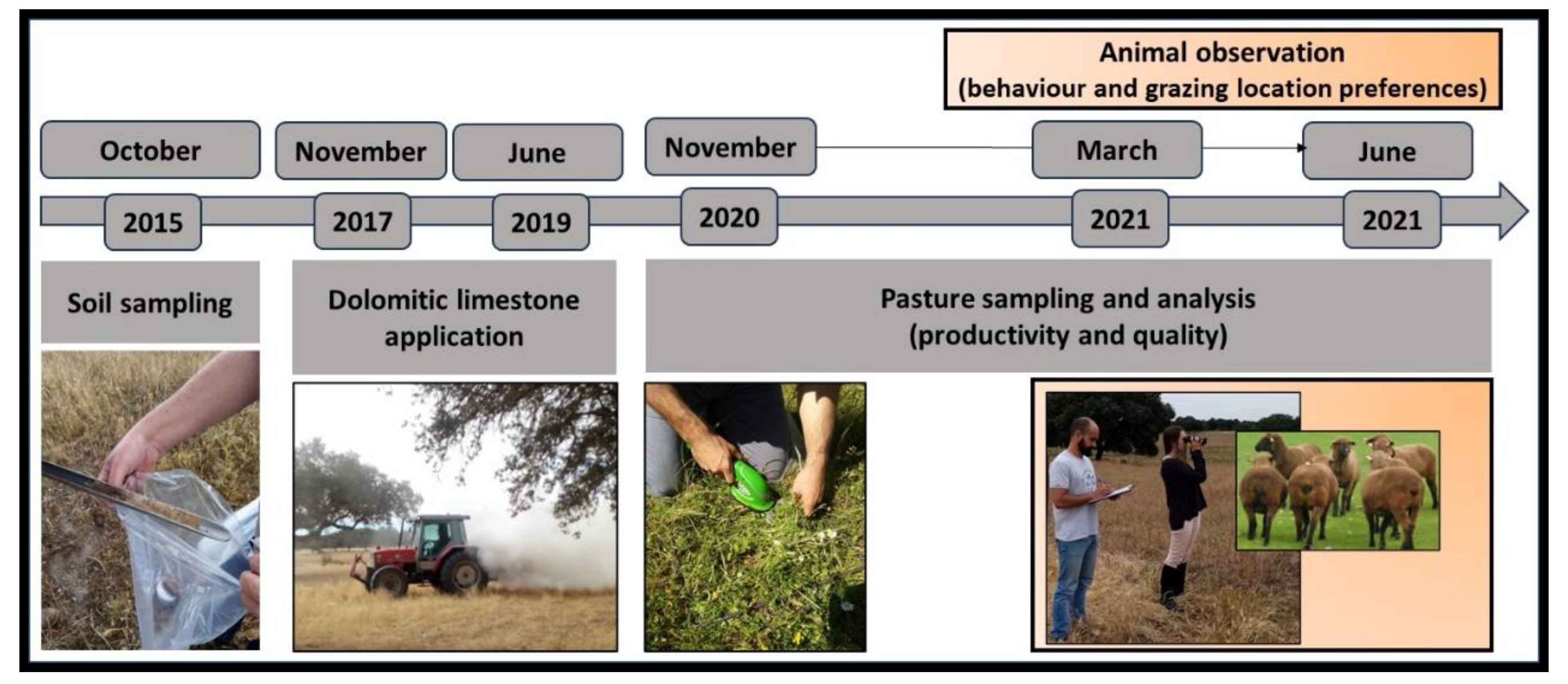
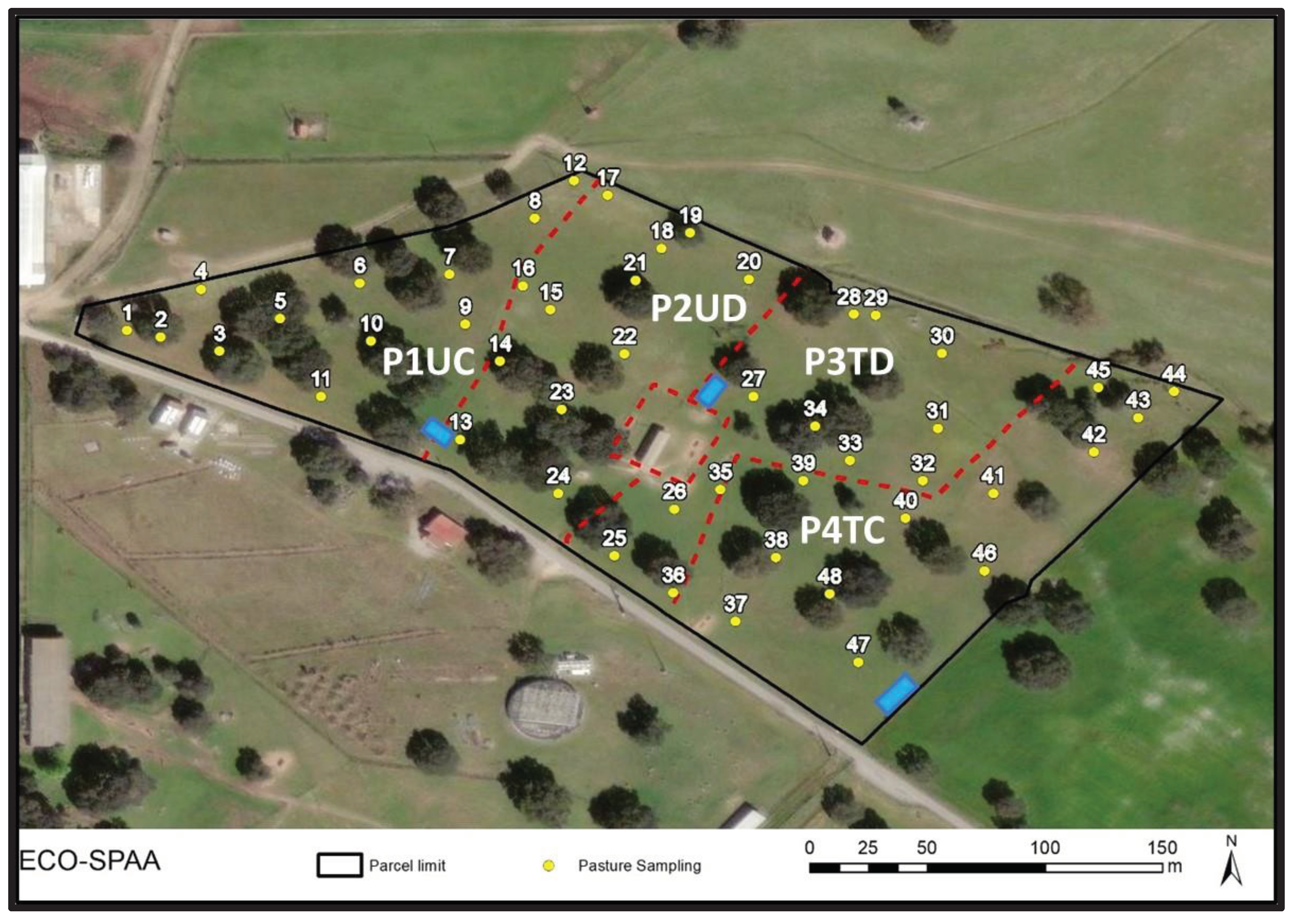
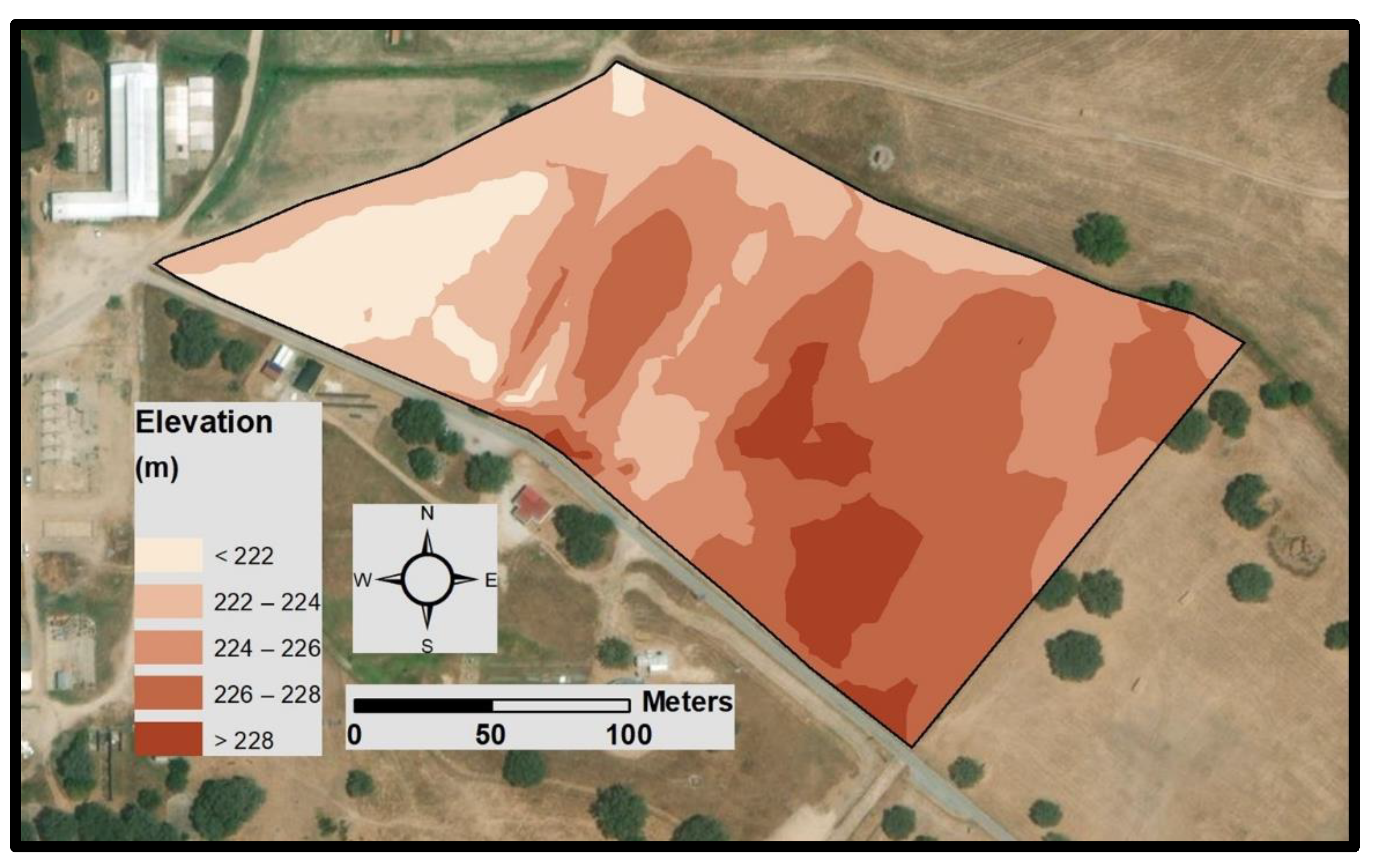
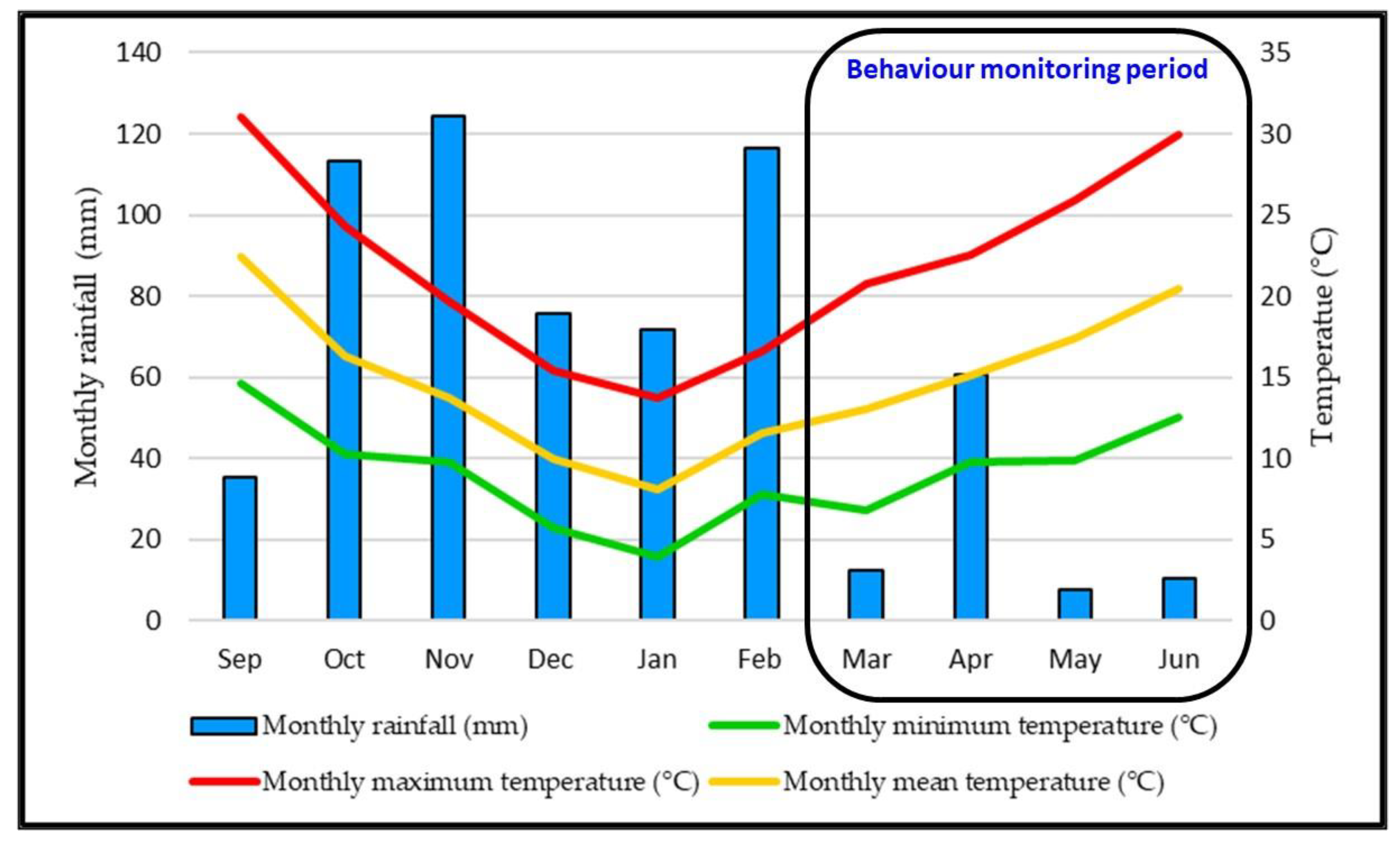
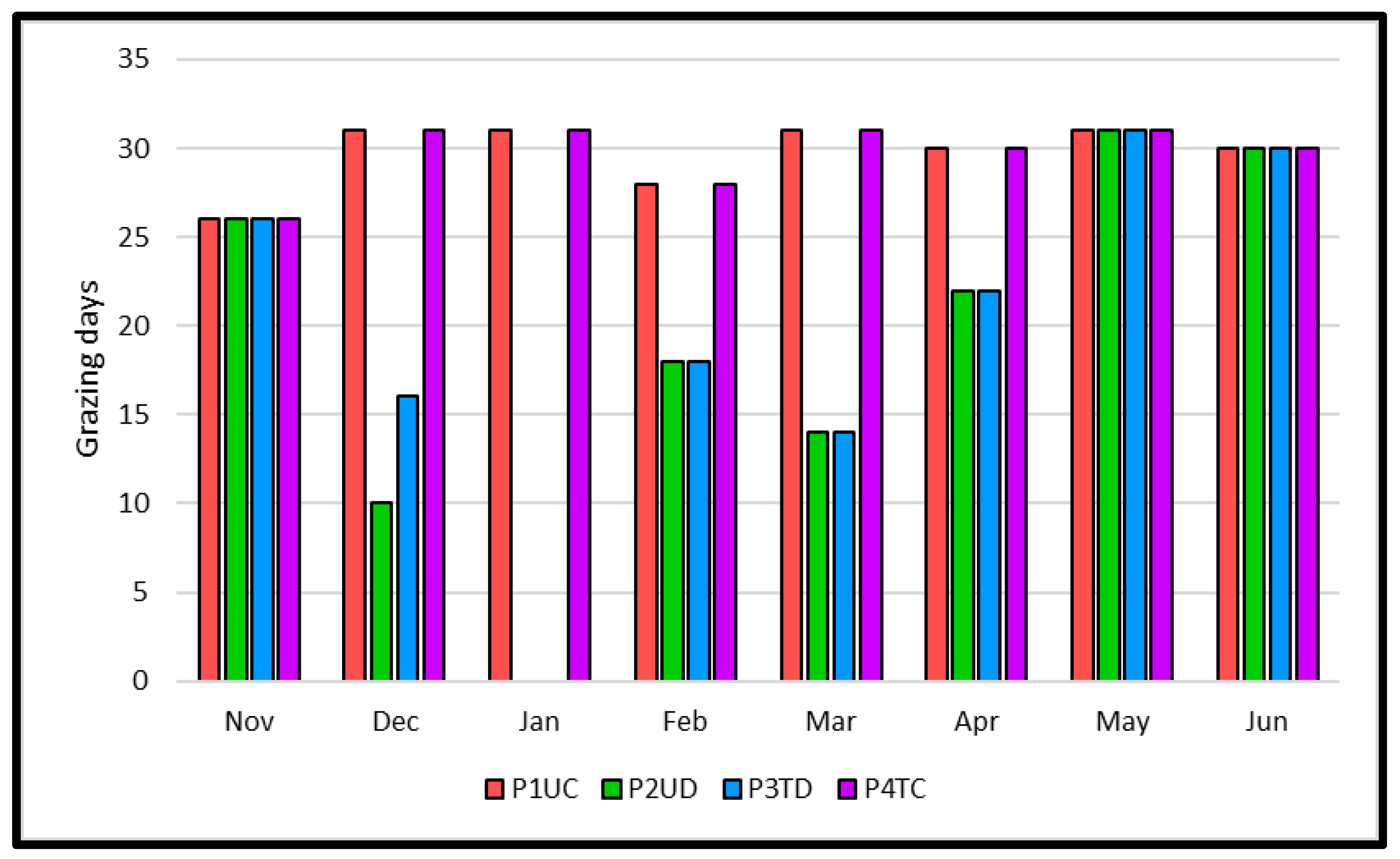
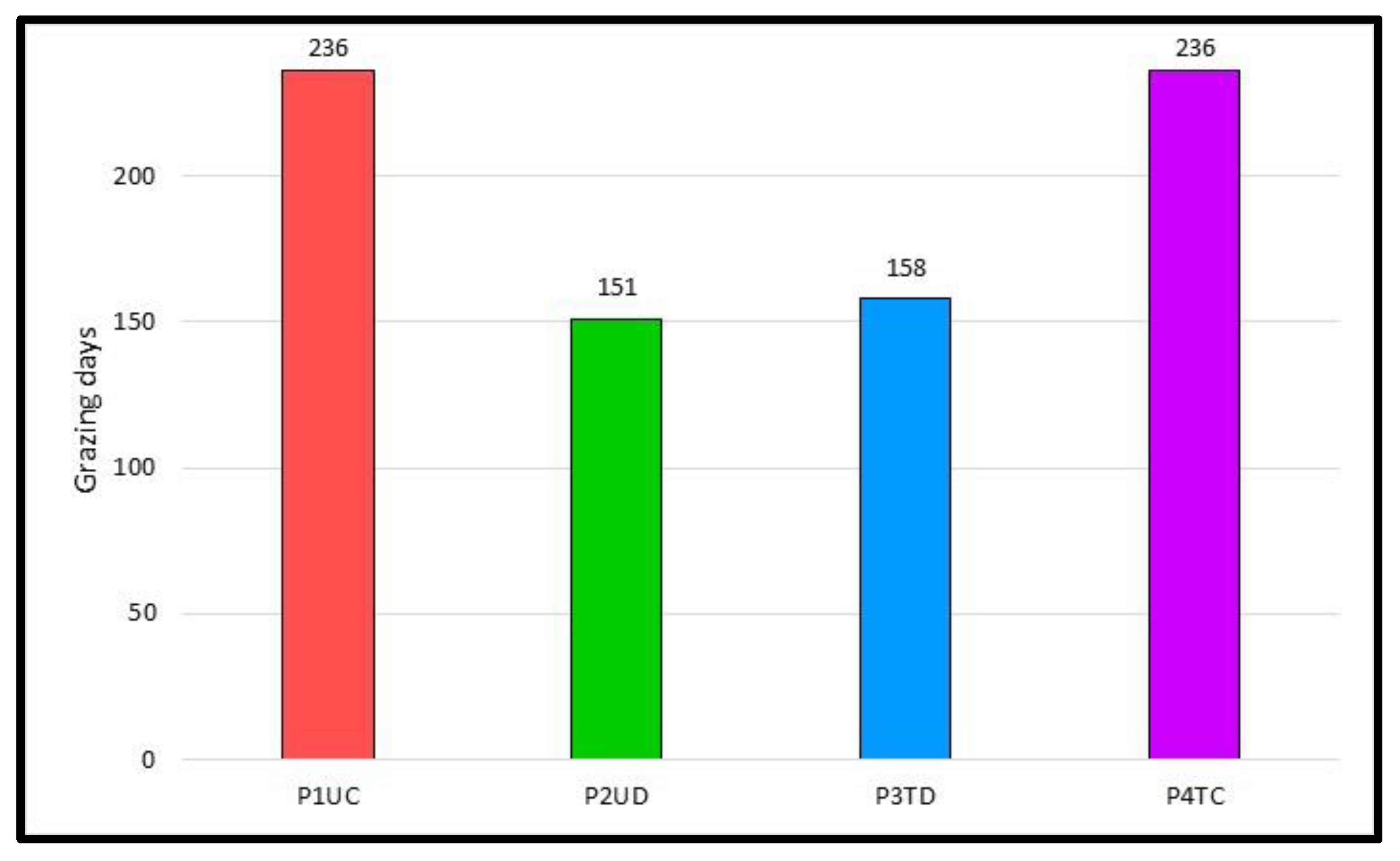
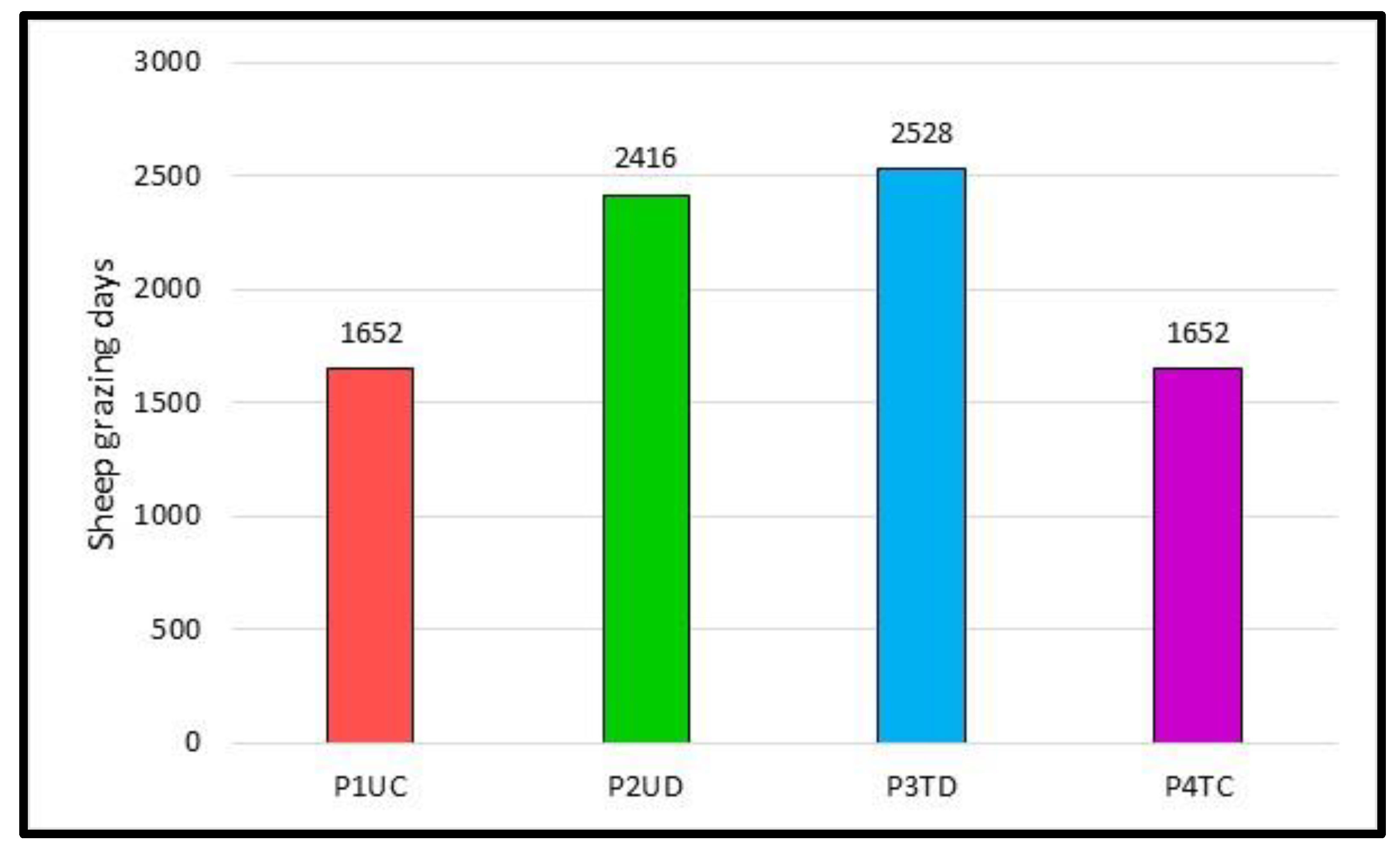
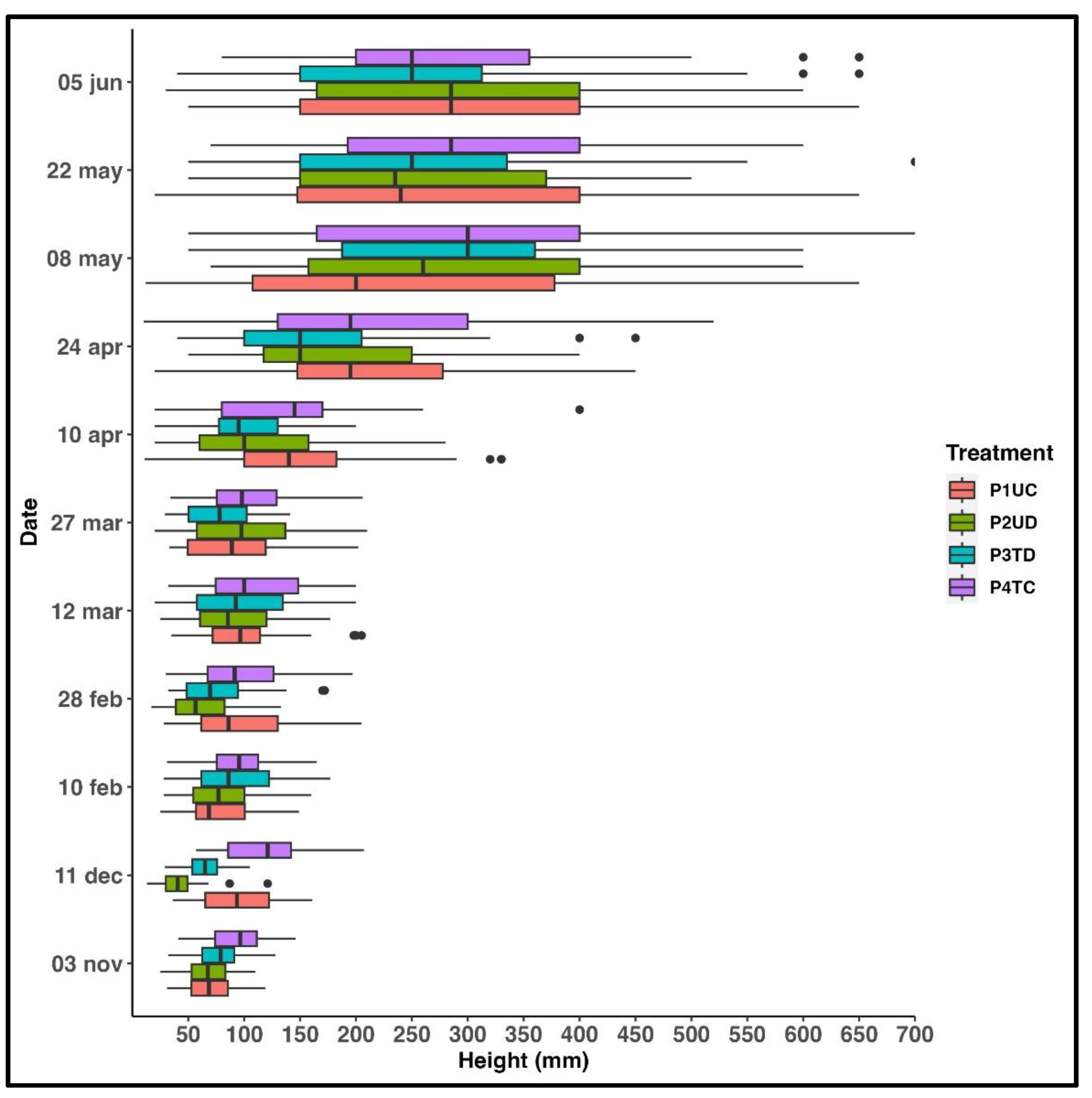
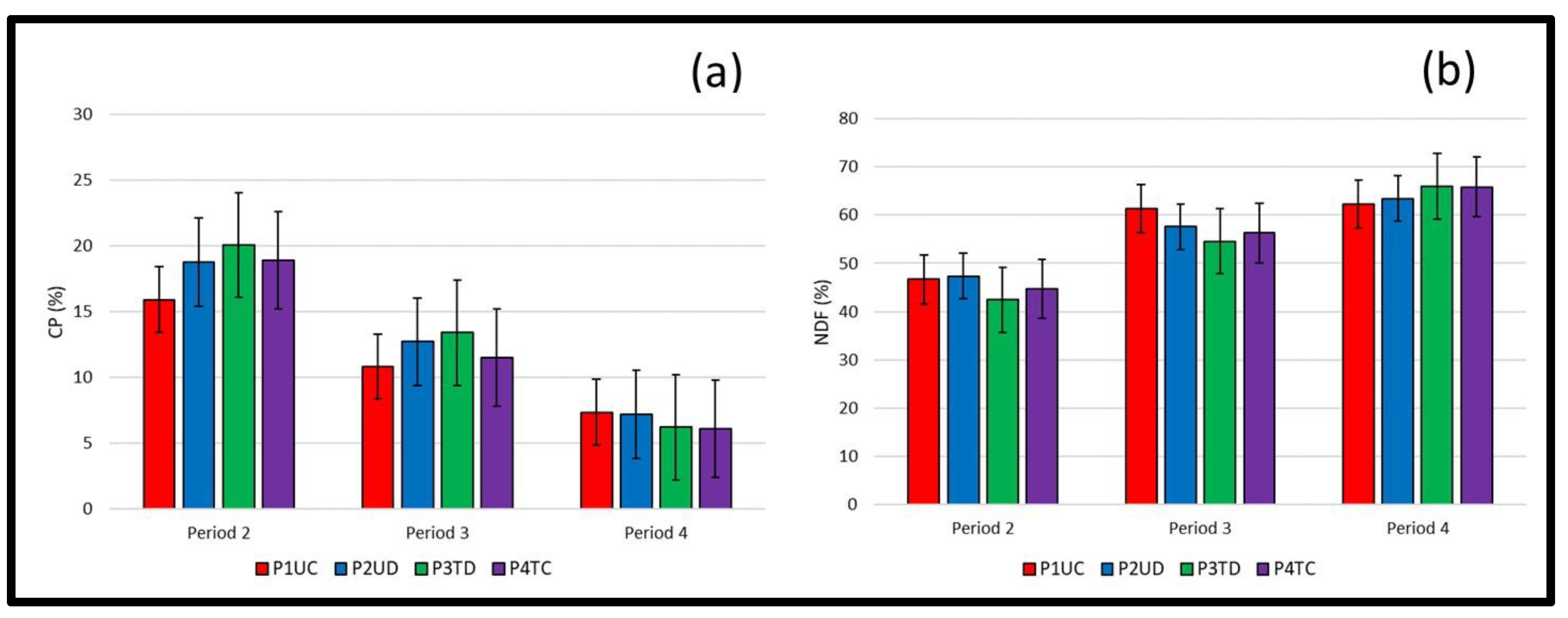
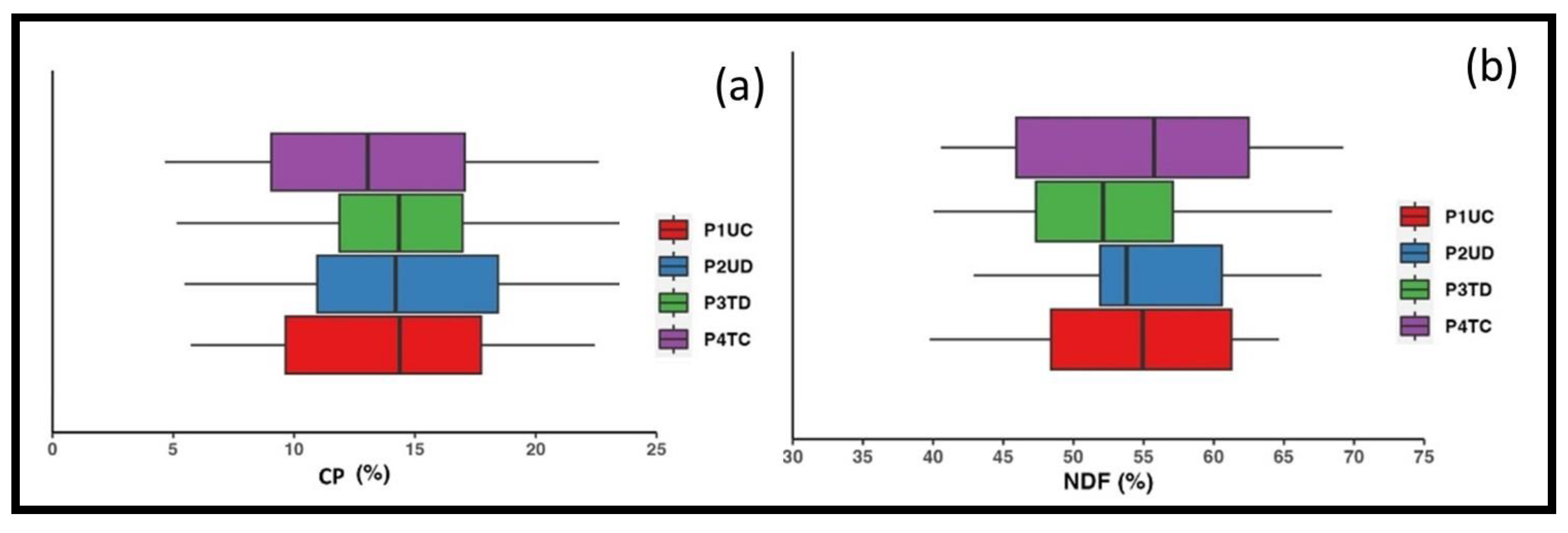
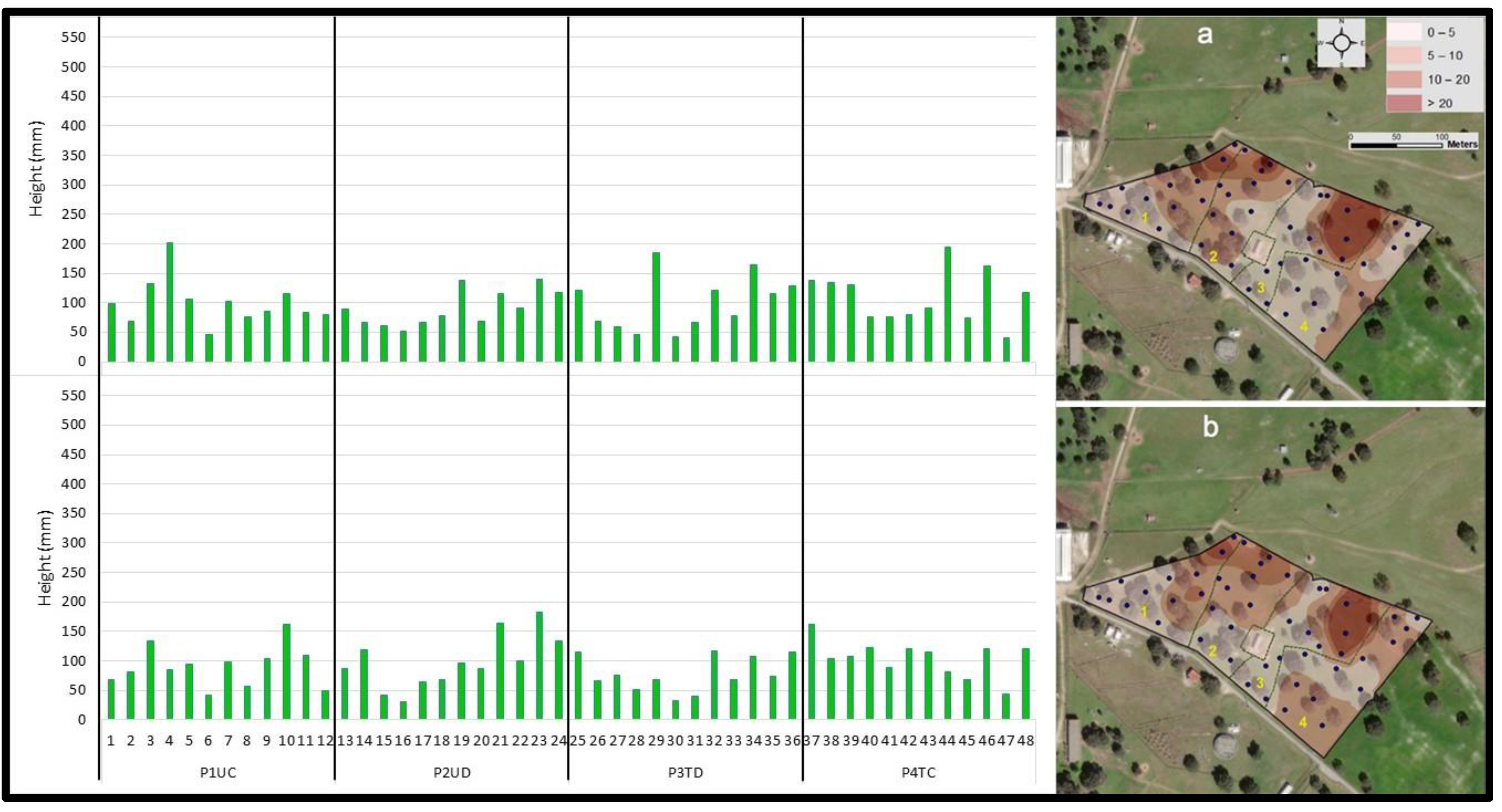
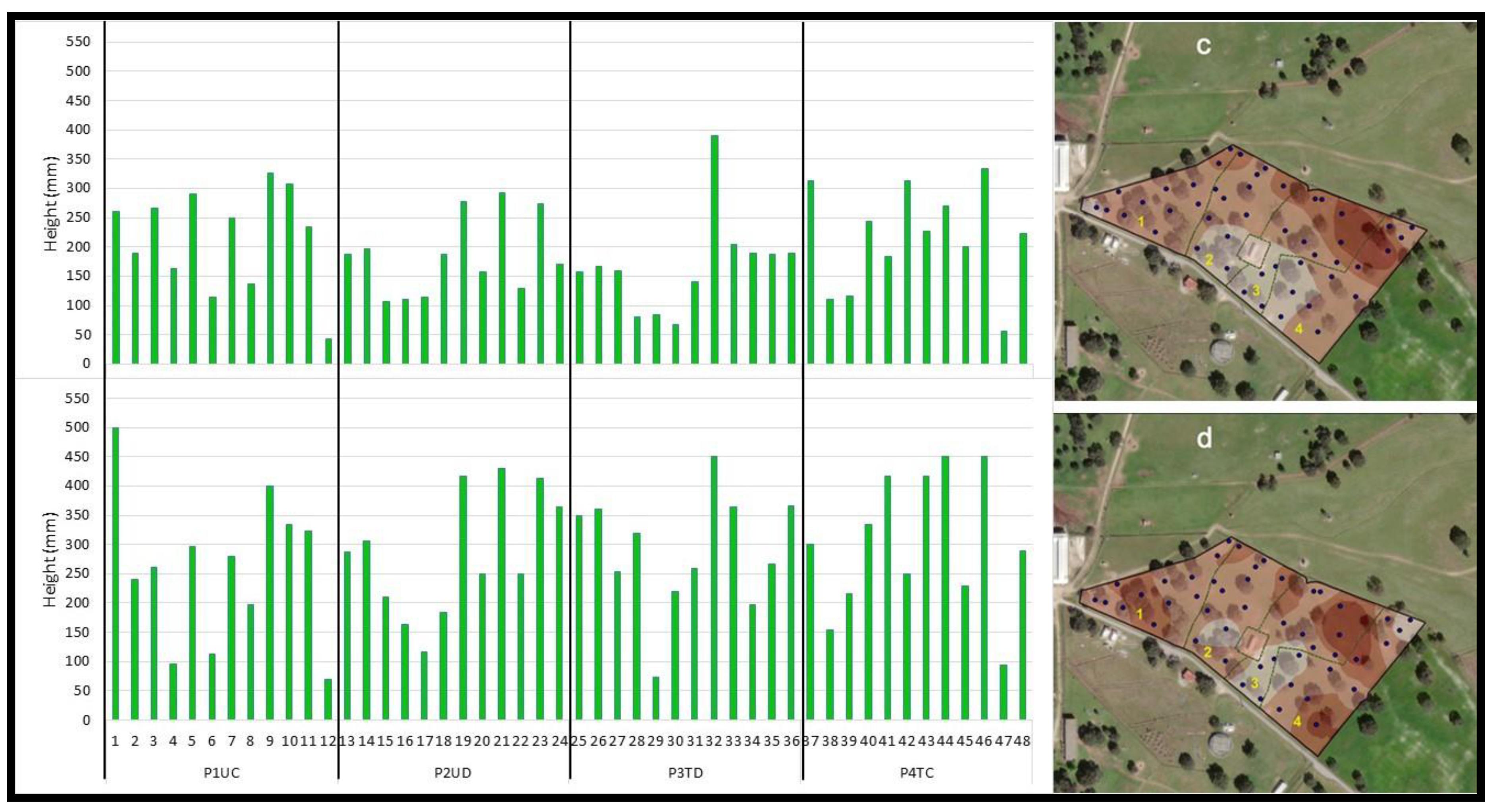
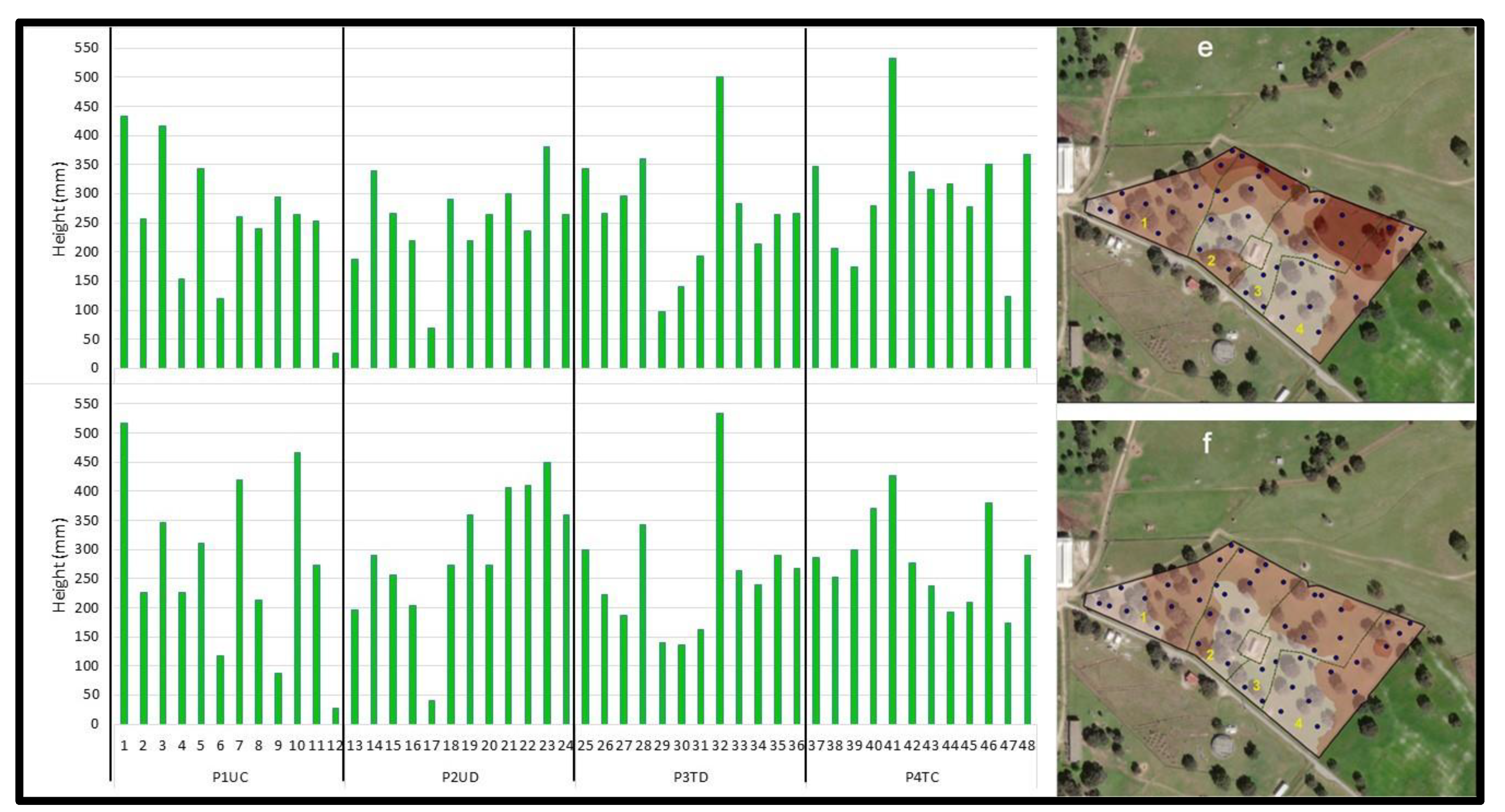
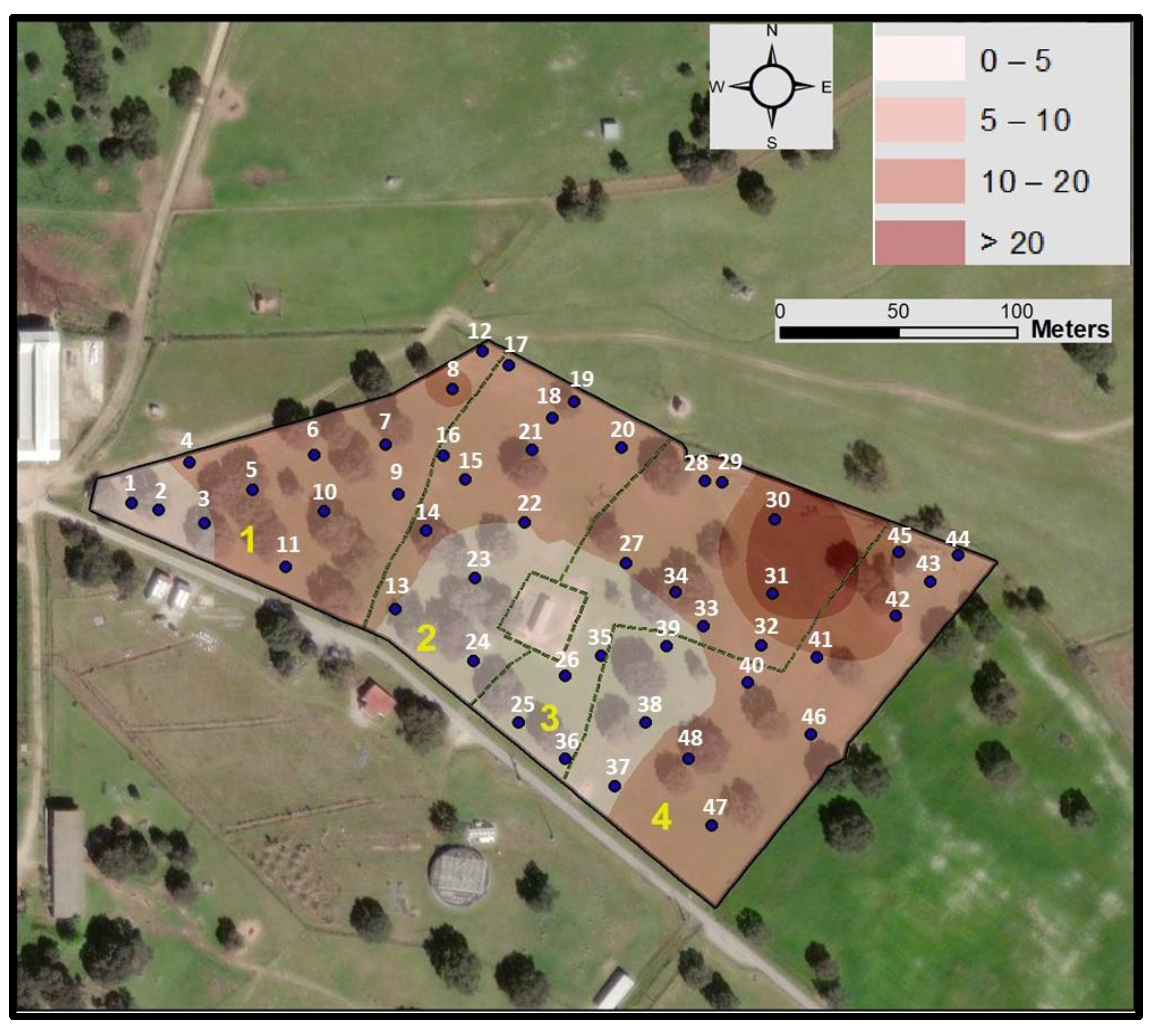
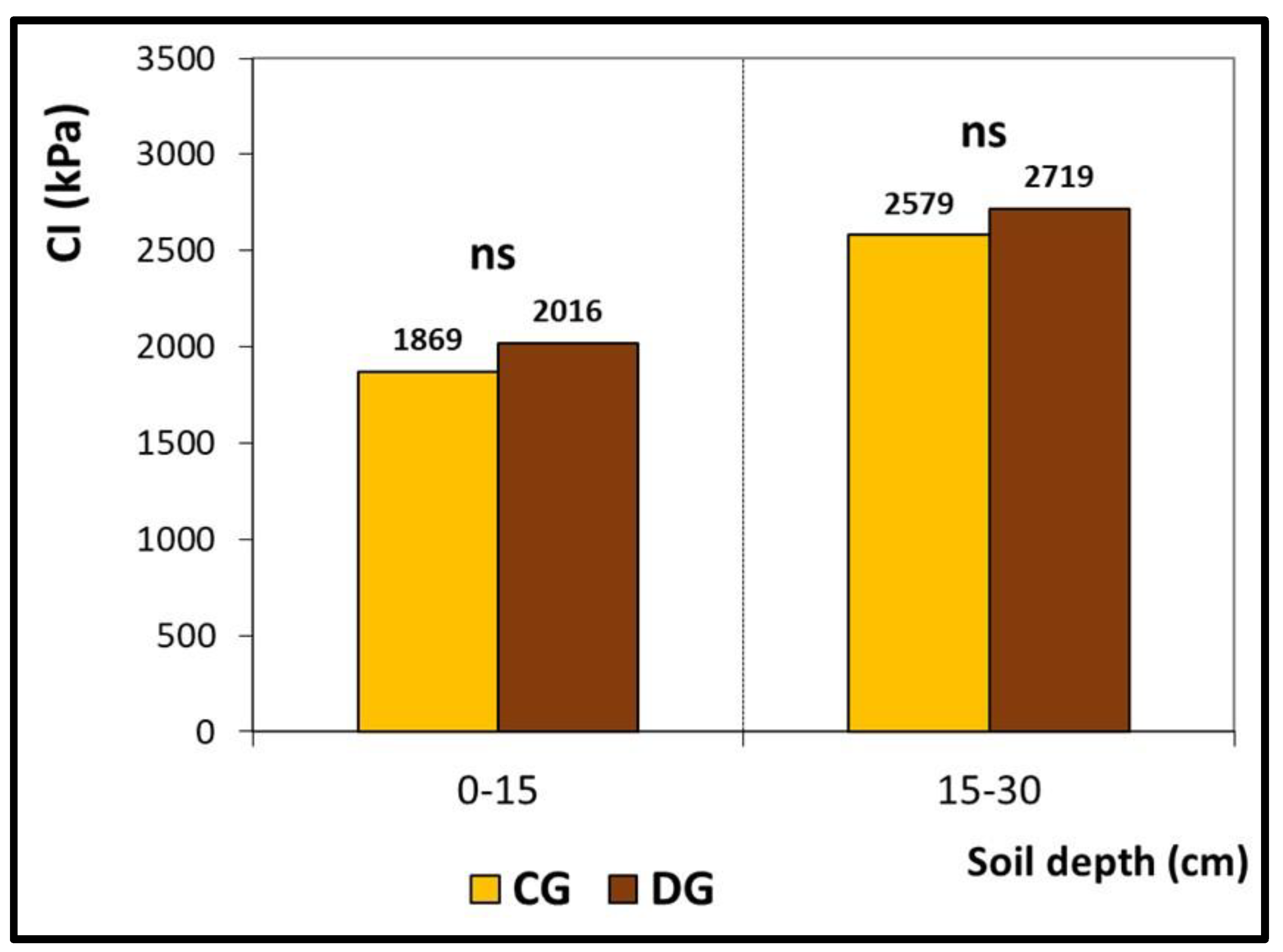

Disclaimer/Publisher’s Note: The statements, opinions and data contained in all publications are solely those of the individual author(s) and contributor(s) and not of MDPI and/or the editor(s). MDPI and/or the editor(s) disclaim responsibility for any injury to people or property resulting from any ideas, methods, instructions or products referred to in the content. |
© 2024 by the authors. Licensee MDPI, Basel, Switzerland. This article is an open access article distributed under the terms and conditions of the Creative Commons Attribution (CC BY) license (http://creativecommons.org/licenses/by/4.0/).





